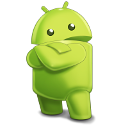 Potrzebujemy wyświetlić listę zawierającą elementy różnego typu. Dla przykładu niech to będzie lista polecanych produktów sklepu na której mogą się znaleźć np. płyta DVD, książka i tp. Lista może też zawierać elementy nie będące produktami jak nagłówek listy czy separator sekcji. Każdy z tych elementów ma swój własny widok z layoutem różnym od pozostałych. Elementy te mają swoje modele danych, reprezentowane przez obiekty różnych klas. Lista może być długa, więc potrzebujemy zarządzania pamięcią jaki oferuje
Potrzebujemy wyświetlić listę zawierającą elementy różnego typu. Dla przykładu niech to będzie lista polecanych produktów sklepu na której mogą się znaleźć np. płyta DVD, książka i tp. Lista może też zawierać elementy nie będące produktami jak nagłówek listy czy separator sekcji. Każdy z tych elementów ma swój własny widok z layoutem różnym od pozostałych. Elementy te mają swoje modele danych, reprezentowane przez obiekty różnych klas. Lista może być długa, więc potrzebujemy zarządzania pamięcią jaki oferuje RecyclerView.
1. Główna aktywność aplikacji i jej layout.
Tworzymy nowy projekt w Android Studio wybierając puste Activity. Do swtorzonej aktywności z layoutem dołączamy kontrolkę typuRecyclerView
res/layout/activity_main.xml
<?xml version="1.0" encoding="utf-8"?>
<LinearLayout xmlns:android="http://schemas.android.com/apk/res/android"
xmlns:tools="http://schemas.android.com/tools"
tools:context="com.mycorp.multielementslist.MainActivity
android:layout_width="match_parent"
android:layout_height="match_parent"
android:orientation="vertical">
<android.support.v7.widget.RecyclerView
android:id="@+id/list_recycler"
android:layout_width="match_parent"
android:layout_height="match_parent"
android:layout_below="@id/title_text"
android:scrollbarStyle="outsideOverlay"
android:scrollbars="vertical" />
</LinearLayout>
MainActivity.java
public class MainActivity extends AppCompatActivity {
private RecyclerView listRecyclerView;
@Override
protected void onCreate(Bundle savedInstanceState) {
super.onCreate(savedInstanceState);
Fresco.initialize(this);
setContentView(R.layout.activity_main);
listRecyclerView = (RecyclerView) findViewById(R.id.list_recycler);
}
}
Nie zapomnij dodać do pliku app/build.gradle w sekcji dependencies linijki:
implementation 'com.android.support:recyclerview-v7:+'
Do ładowania zdjęć okładek z sieci użyjemy biblioteki Fresco. Dzięki temu będziemy mieć obsłużone ładowanie, cache’owanie obrazków i wydajne zarządzanie pamięcią. Inicjalizację biblioteki należy umieścić przed wywołaniem setContentView inaczej otrzymamy błąd "Error inflating class com.facebook.drawee.view.SimpleDraweeView". Do pliku app/build.gradle dodajemy oczywiście zależność od tej biblioteki:
compile 'com.facebook.fresco:fresco:1.7.1'
2. Klasy elementów.
Stwórzmy teraz modele reprezentujące dane potrzebnych elementów, czyli książki, płyty DVD oraz nagłówka listy:
model/Book.java
public class Book {
private String title;
private String author;
private String coverUrl;
public Book(String title, String author, String coverUrl) {
this.title = title;
this.author = author;
this.coverUrl = coverUrl;
}
// here getters and setters
// ...
}
model/DVD.java
public class Dvd {
private String title;
private String description;
private String coverUrl;
public Dvd(String title, String description, String coverUrl) {
this.title = title;
this.description = description;
this.coverUrl = coverUrl;
}
// ...
}
model/DVD.java
public class Header {
private String title;
private String subTitle;
public Header(String title, String subTitle) {
this.title = title;
this.subTitle = subTitle;
}
// ...
}
3. Klasa reprezentująca element listy.
Klasa reprezentująca element listy będzie niejako kontenerem na obiekty modelów z poprzedniego punktu. Będzie zawierać typ przechowywanego obiektu zdefiniowany w enumeratorze ItemType. Na potrzeby naszego przykładu powstały trzy typy: HEADER, BOOK, DVD. Dzięki temu adapter będzie wiedzieć, jakiego widoku użyć do wyrenderowania danego elementu.
RecycledListItem.java
public class RecycledListItem {
public enum ItemType {
HEADER, BOOK, DVD
}
private ItemType type;
private Header header;
private Book book;
private Dvd dvd;
public RecycledListItem(Header haeder) {
this.header = header;
this.type = ItemType.HEADER;
}
public RecycledListItem(Book book) {
this.book = book;
this.type = ItemType.BOOK;
}
public RecycledListItem(Dvd book) {
this.dvd = book;
this.type = ItemType.DVD;
}
public ItemType getType() {
return type;
}
public Object getItem() {
if (ItemType.HEADER.equals(this.type)) {
return this.header;
} else if (ItemType.BOOK.equals(this.type)) {
return this.book;
} else if (ItemType.DVD.equals(this.type)) {
return this.dvd;
} else {
return null;
}
}
}
Przeciążyliśmy konstruktor, aby można było tworzyć kontener dla różnych klas modeli. Metodą getItem pobierzemy obiekt właściwego typu.
4. Widoki elementów
Zaprojektujemy teraz layouty dla poszczególnych elementów.
res/layout/header_item_layout.xml
<?xml version="1.0" encoding="utf-8"?>
<FrameLayout
xmlns:android="http://schemas.android.com/apk/res/android"
android:layout_width="match_parent"
android:layout_height="wrap_content"
android:background="@drawable/box_with_shadow"
android:padding="10dp"
android:layout_margin="10dp">
<TextView
android:id="@+id/dvd_title_text"
android:layout_width="wrap_content"
android:layout_height="wrap_content"
android:textSize="25sp"
android:textAllCaps="true"
android:textStyle="bold"
android:text="Section header" />
</FrameLayout>
res/layout/dvd_item_layout.xml
<?xml version="1.0" encoding="utf-8"?>
<FrameLayout
xmlns:android="http://schemas.android.com/apk/res/android"
xmlns:fresco="http://schemas.android.com/apk/res-auto"
android:layout_width="match_parent"
android:layout_height="wrap_content"
android:background="@drawable/box_with_shadow"
android:padding="15dp"
android:layout_margin="10dp">
<RelativeLayout
android:layout_width="match_parent"
android:layout_height="match_parent">
<com.facebook.drawee.view.SimpleDraweeView
android:id="@+id/dvd_cover_drawee"
android:layout_width="120dp"
android:layout_height="160dp"
fresco:placeholderImage="@drawable/dvd"
android:layout_marginRight="10dp"
android:scaleType="centerCrop" />
<TextView
android:id="@+id/dvd_title_text"
android:layout_toRightOf="@+id/dvd_cover_drawee"
android:layout_width="wrap_content"
android:layout_height="wrap_content"
android:textSize="25sp"
android:layout_marginBottom="3dp"
android:text="Star Wars ep. IV" />
<TextView
android:id="@+id/dvd_description_text"
android:layout_toRightOf="@+id/dvd_cover_drawee"
android:layout_below="@+id/dvd_title_text"
android:layout_width="wrap_content"
android:layout_height="wrap_content"
android:layout_marginBottom="10dp"
android:textSize="12sp"
android:text="A young boy from Tatooine sets out on an adventure with an old Jedi named Obi-Wan Kenobi as his mentor to save Princess Leia." />
<Button
android:id="@+id/book_download_button"
android:layout_width="wrap_content"
android:layout_height="wrap_content"
android:layout_toRightOf="@+id/dvd_cover_drawee"
android:layout_below="@+id/dvd_description_text"
android:textAllCaps="false"
android:text="Watch trailer"/>
</RelativeLayout>
</FrameLayout>
res/layout/book_item_layout.xml
<?xml version="1.0" encoding="utf-8"?>
<FrameLayout
xmlns:android="http://schemas.android.com/apk/res/android"
xmlns:fresco="http://schemas.android.com/apk/res-auto"
android:layout_width="match_parent"
android:layout_height="wrap_content"
android:background="@drawable/box_with_shadow"
android:padding="15dp"
android:layout_margin="10dp">
<RelativeLayout
android:layout_width="match_parent"
android:layout_height="match_parent">
<com.facebook.drawee.view.SimpleDraweeView
android:id="@+id/book_cover_drawee"
android:layout_width="120dp"
android:layout_height="160dp"
fresco:placeholderImage="@drawable/book"
android:layout_marginLeft="10dp"
android:layout_alignParentRight="true"
android:scaleType="centerCrop" />
<TextView
android:id="@+id/book_title_text"
android:layout_toLeftOf="@+id/book_cover_drawee"
android:layout_width="wrap_content"
android:layout_height="wrap_content"
android:textSize="25sp"
android:layout_marginBottom="3dp"
android:layout_alignParentLeft="true"
android:text="Lord of The Rings" />
<TextView
android:id="@+id/book_author_text"
android:layout_toLeftOf="@+id/book_cover_drawee"
android:layout_below="@+id/book_title_text"
android:layout_width="wrap_content"
android:layout_height="wrap_content"
android:layout_marginBottom="10dp"
android:layout_alignParentLeft="true"
android:textSize="18sp"
android:text="J. R. R. Tolkien" />
<TextView
android:id="@+id/book_description_text"
android:layout_toLeftOf="@+id/book_cover_drawee"
android:layout_below="@+id/book_author_text"
android:layout_width="wrap_content"
android:layout_height="wrap_content"
android:layout_marginBottom="10dp"
android:layout_alignParentLeft="true"
android:textSize="12sp"
android:text="A young Hobbit named Frodo is thrown on an amazing adventure, when he is appointed the job of destroying the one ring which was created by the dark lord Sauron." />
</RelativeLayout>
</FrameLayout>
Elementy będą miały wygląd kafelków z zaokrąglonymi rogami oraz cieniem, należy więc zdefiniować ich kształt:
res/drawable/box_with_shadow/item_layout.xml
<?xml version="1.0" encoding="utf-8"?>
<layer-list xmlns:android="http://schemas.android.com/apk/res/android">
<item>
<shape android:shape="rectangle">
<solid android:color="#CABBBBBB"/>
<corners android:radius="5dp" />
</shape>
</item>
<item
android:left="0dp"
android:right="0dp"
android:top="0dp"
android:bottom="2dp">
<shape android:shape="rectangle">
<solid android:color="@android:color/white"/>
<corners android:radius="5dp" />
</shape>
</item>
</layer-list>
Umieśćmy też testowo obrazki okładek w res/drawable: book.jpg oraz dvd.jpg. Podczas docelowego ładowania obrazków z sieci powinna wyświetlać się też zaślepka: placeholder.png. Docelowo podmień w tagach SimpleDraweeView testowe obrazki na tę zaślepkę:
<com.facebook.drawee.view.SimpleDraweeView
...
fresco:placeholderImage="@drawable/book"
...
/>
Sprawdźmy, jak będą prezentować się nasze elementy. Dodajmy je tymczasowo do głównego layoutu, powyżej tagu
...
<include layout="@layout/header_item_layout"/>
<include layout="@layout/dvd_item_layout"/>
<include layout="@layout/book_item_layout"/>
<android.support.v7.widget.RecyclerView
...
Powinniśmy otrzymać następujący ekran:

Na ten moment mamy zdefiniowane elementy, ich modele i layouty. W następnej części artykułu dowiemy się czym jest ViewHolder, oraz jak stworzyć listę naszych elementów aby renderowały się w kontrolce RecyclerView.
Cały kod źródłowy dostępny jest na GitHubie.